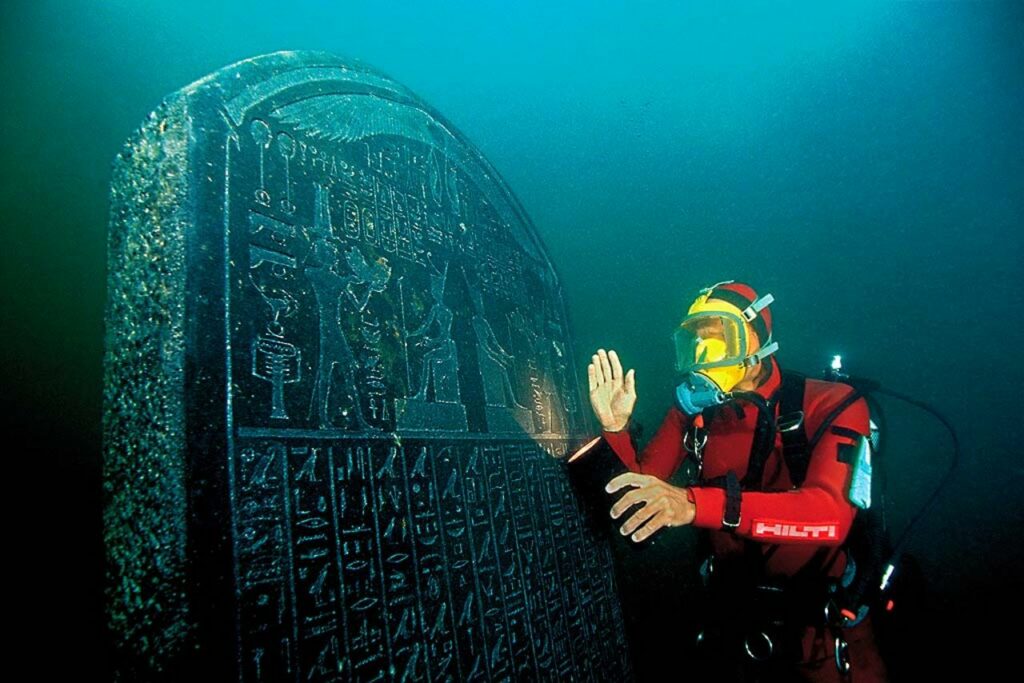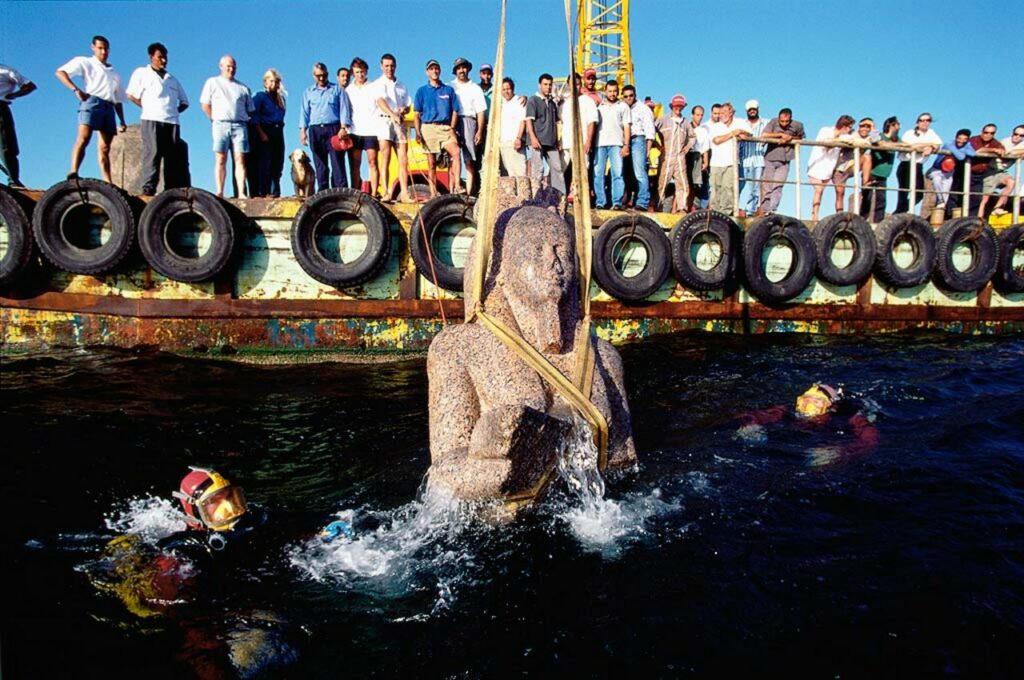Almost everyone has heard of Atlantis. The mythical tale of the fabled continent with its advanced civilization, lost beneath the Atlantic Ocean. Or of El Dorado, the legendary city of gold hidden deep within the South American jungles.
Lost cities have long captivated our collective imagination. Yet, there is one lost city that gets overlooked. A city that truly did exist but was consumed by the waters of the Mediterranean Sea.
Heracleion, also known as Thonis, was once a flourishing Egyptian port city, situated on the mouth of the Nile River. As sea levels rose and the Nile continued to deposit silt, the once great city became lost beneath the waves.
Its culture, wealth, and history were lost for centuries until it was rediscovered very recently. This is the story of the real-life lost city of Heracleion.

Historical Significance of Heracleion
The ancient city of Heracleion was situated northeast of Alexandria at the mouth of the Nile River. During its peak, Heracleion was a bustling maritime city that played an important role in shaping Egyptian history and the broader cultural history of the ancient Mediterranean.
Its strategic location on the mouth of the Nile made it an international melting pot that helped spread the exchange of goods, ideas, and cultures.
Merchants and travelers from Greece, Phoenicia, and beyond docked their ships at this thriving metropolis and contributed to cultural exchange. Foreign influences also helped to impact the art, architecture, and religious practices in Egypt.
During the second century BC, the nearby city of Alexandria began to gradually take precedence over Heracleion as Egypt’s principal port. This contributed to its decline.
This diminishing importance of Heracleion was exacerbated when a major natural disaster significantly damaged the city. Researchers have tossed around the possibility that a tsunami, earthquake, or a combination of both, could have been responsible.
Around 101 BC, the very ground on which Heracleion rested experienced what is known as soil liquefaction. A phenomenon that turned the once-sturdy clay terrain into a watery swamp, swallowing the grand temples and accelerating the city’s demise.
However, despite its decline, the city wasn’t entirely deserted until it was completely consumed by the Mediterranean Sea sometime during the eighth century AD.
Discovery and Rediscovery
Ancient accounts of Heracleion date back to the writings of ancient historians such as Herodotus and Strabo, who marveled at its beauty and rich culture. Originally it was believed that Heracleion and the city of Thonis were one and the same.
But it was discovered later that “Thonis” was the Greek name for Heracleion. This revealed that the Greeks were trading with the Egyptians earlier than previously thought.
For centuries, the ancient city of Heracleion remained lost, a figment in the realm of myth and folklore. That is until 2001 when French archaeologist, Franck Goddio and his team, used historical texts, nuclear magnetic resonance magnetometers, bathymetry, and sonar to locate and map the submerged ruins.
Goddio and his team began mapping the area around the port of Alexandria in 1992. Four years later they broadened their search into the Aboukir Bay. That’s when their mapping equipment picked up strange anomalies on the ocean floor.

Upon closer inspection, it was revealed that the ancient city was covered with sediment deposited by the Nile River. This was because the city was built on the Nile delta where the river emptied into the sea.
This helped researchers understand why the city was lost for so long. It was buried beneath the ocean floor.
Underwater Archaeological Expeditions
After the city was rediscovered in the early 21st century, archaeologists attempted to survey and map the city. But its depth has made that objective very difficult. Some areas of Heracleion lie over 30 meters beneath the Mediterranean Sea.
To help in their search, archaeologists use advanced diving equipment, remotely operated vehicles (ROVs), and sonar technology to navigate and excavate the submerged site.
These expeditions have revealed a wealth of remarkably preserved artifacts, statues, and intricate temple complexes. The artifacts provide a glimpse into the daily life of ancient Egypt and its role in the ancient world, and the legacy it left behind.
Remarkable Artifacts and Findings
The underwater excavations at Heracleion have yielded a treasure trove of artifacts that will keep researchers busy for years.
By studying them, researchers can build a better understanding of what life was like in the 8th century BC. The presence of Greek inscriptions and the evidence of trade connections have revealed that ancient Egypt was a more international influence than was previously known.
Some of the more notable discoveries found at the site include:
Statue of Hapi: One of the most exciting discoveries that have been made is the colossal statue of a pharaoh believed to be a representation of Hapi, the god of the annual flooding of the Nile. The sheer size and detail of this statue underscores how important the Nile was in the lives of ancient Egyptians.
Intricate Temple Structures: The remnants of the Temple of Amun-Gereb, showcase the religious significance of Heracleion. These temples played a central role in ancient Egyptian spirituality and were centers of worship and rituals.
Everyday Objects: Artifacts like pottery, jewelry, and glassware provide insights into the daily life of the city’s inhabitants.
Heracleion’s Influence on Modern Culture
The rediscovery of Heracleion has not only enriched the world’s historical understanding but has also ignited curiosity and creativity in contemporary culture. It has inspired various forms of artistic media including documentaries, books, and exhibits where people can learn more about this fascinating city.
Documentaries: Documentaries like “Heracleion: Sunken City of Egypt” and “Lost Worlds: The Sunken City of Heracleion” have delved into the city’s history and the underwater archaeological expeditions that led to its discovery.
Books: Works like “Heracleion: The City of Herakles” and “Egypt’s Lost City: The Watery Grave of Heracleion” explore the city’s history, significance, and the profound impact of its rediscovery.
Exhibitions: Museums and cultural institutions have showcased artifacts and findings from the underwater site. Exhibitions such as “Heracleion: The Legend Revealed” provide a deeper appreciation of its significance in ancient Egypt.
Conclusion
The sunken city of Heracleion offers a fascinating window into the past.
This ancient city has unveiled remarkable insights into the ancient Egyptian civilization, its cultural richness, and its prominence as a vital trading and religious center. The ongoing explorations of Heracleion continue to reveal secrets from its past and shed light on the life of ancient Egypt.
References
Discovering The Heracleion’s Lost City: Meeting Myth Beneath The Waves
Treasure Trove Discovered at Egypt’s Atlantis, Where Cleopatra Was Crowned
https://www.thedailybeast.com/heracleion-treasure-trove-discovered-at-egypts-atlantis
Heracleion

